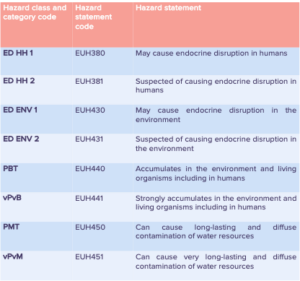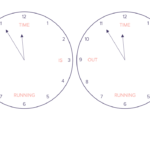UPDATE! New hazard classes under CLP
New CLP hazard classes
The European Commission has published a Delegated Regulation amending the CLP Regulation, which sets out new hazard classes and criteria for the classification, labelling and packaging of substances and mixtures.
The new introduced hazard classes are:
- ED (Endocrine disruptors for human health and for the environment)
- PBT/vPvB substances: substances with persistent, bioaccumulative and toxic properties or very persistent, very bioaccumulative properties
- PMT/vPvM substances: substances with persistent, mobile and toxic properties or very persistent, very mobile properties
For the ED-type properties, experience and scientific knowledge was gained through the process of SVHC identification under REACH. For the PBT/vPvB-type substances, knowledge originates from the application of Annex XIII from REACH. The inclusion of PMT and vPvM properties is new, with the exception that the ‘(v)P’ criteria are the same compared to the PBT/vPvB properties obviously. For the ‘T’ properties classification, besides the criteria in the Annex XIII from REACH, an additional criterion is added into the CLP regulation. According to this new criterion, if the substance meets the criteria for classification as endocrine disruptor (category 1) for human health or the environment, it shall be considered to fulfil the toxicity criterion, hence classified as T.
In practice, following categories/classes for classification of the new hazard classes will be applicable:

The distinction between ED HH category 1 and 2 will be based on the amount of evidence that can be presented related to the following:
(a) endocrine activity
(b) an adverse effect in an intact orgasnism or its offspring or future generations;
(c) a biologically plausible link between the endocrine activity and the adverse effect
And evidence provided in function of demonstrating this may be based on at least one of the following:
(a) human or animal data;
(b) both human and animal data:
(c) non-animal data providing an equivalent level of evidence as for points a or b
In case there is serious doubt on the relevance of the adverse effects to humans, Cat. 2 might be more appropriate and in cases where evidence can conclusively demonstrate that the adverse effects are not relevant to humans, it is describe that the substance ‘shall not be considered an endocrine disruptor for human health’.
For classification as ED for the environment, the criteria that need to be fulfilled are similar to those for determining the ED properties for human health, the only difference is that this will be largely based on evidence from at least one of the following:
(a) animal data;
(b) non-animal data providing an equivalent level of evidence as for point a.
Overall, for the identification of the ED criteria, it has now been clarified in this current draft that information from structural analogues and read-across as well as non-animal data, e.g. data from new approach methodologies (NAMs) can be used to concluded on Cat.1 ED properties. This is an important clarification as it allows not only the use of non-animal test methods which are available today but also those which will be developed in the future.
Evaluation of the (v)P, (v)B and T properties – in function of the PBT, vPvB, PMT and vPvM hazard classes – will be evaluated based on the principles and criteria currently applied within Annex XIII of REACH, except for T, there is an additional criterion which is if the substance meets the criteria for classification as endocrine disruptor (category 1) for human health or the environment, it shall be considered to fulfil the toxicity criterion, hence classified as T. Other information, for example information relevant for the evaluation of the screening criteria, is also still relevant when used in a Weight of Evidence situation. The Mobility criterion which is new, will typically be determined based on the Log Koc value. In case the Log Koc is < 3 the substance will be identified as ‘M’, in case the log Koc is < 2, the substance will be identified as ‘vM’. This will be determined via testing, or in case of a WoE approach via well developed and reliable QSAR methods.
A link to the updated Regulation can be found here.
Process & timeline
The addition the new hazard classes, part of the Annexes of CLP Regulation, will take place via delegated Acts instead of the ‘normal’ procedure. This procedure was selected as it ensures a quicker procedure compared to the ordinary route. This ‘fast-tracking’ adjustment of the CLP hazard classes fits within the broader scheme of EU COM to revise the Regulation within the framework of the Chemical strategy for sustainability.
Key question obviously remains when these new hazard classes will effectively enter into force.
The new rules are in for as of 20 April 2023 (see the figure below). The transitional periods are 24 months and 36 months for substances and mixtures respectively. This means that new substances need to be classified according to new criteria from 1 May 2025. For substances which were placed on the market before 1 May 2025, new criteria will apply from 1 November 2026. In case of classification of mixtures, the valid day is 1 May 2026 for new mixtures and 1 May 2028 for mixtures which were placed on the market before 1 May 2026, respectively.

Essential to ensuring that the implementation of these hazard classes can take place successfully is obviously also availability of guidance. Detailed guidance to determine what sufficient evidence for classification within the new hazard classes (ED & PMT) entails will be due in 2024 according to ECHAas implementation of these concepts, and the interpretation of results of tests in function of these endpoints will not be straightforward.
Relevant Apeiron Services
In doubt whether and in which way this can impact your substance portfolio? Contact us for more info!
Like the sound of Apeiron?
We'd love to know more about you! We are always looking for people who are driven by passion.



